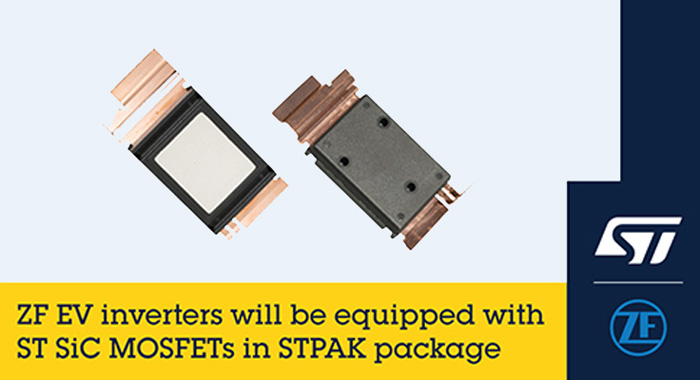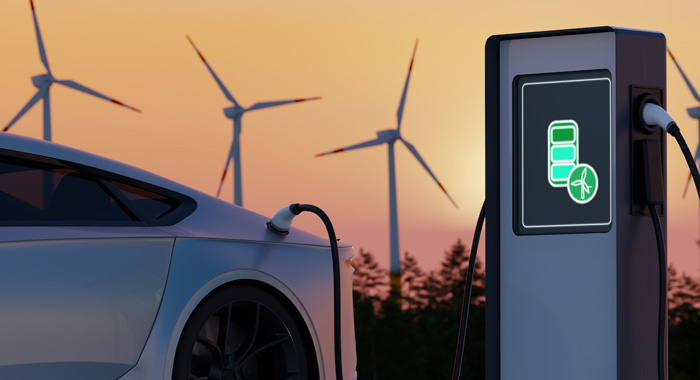STMicroelectronics has signed a long-term supply agreement with ZF to supply its higher-performance carbon, lower power consumption, and more reliable silicon carbide devices, providing better solutions for ZF's automotive power systems. ZF plans to integrate these devices into a new modular inverter architecture for mass production in 2025, using STM's silicon carbide vertically integrated production lines in Europe and Asia to ensure the completion of electric drive customer orders.

Source: Internet
Silicon carbide devices are commonly used in switching and control circuits in automotive power systems. STM will supply more than ten million third-generation SiC MOSFET devices to ZF starting in 2025. ZF can connect different numbers of SiC chips to meet customer performance requirements without changing the inverter design. The technology will serve a European automaker in developing electric drive inverters.
STM will produce silicon carbide chips in its fabs in Italy and Singapore, using STM's advanced STPAK packaging, and complete testing in the back-end factories in Morocco and China.
SiC Semiconductors
Silicon Carbide (SiC) is gaining traction in the semiconductor industry due to its potential to revolutionize the way we use and interact with electronics. SiC semiconductors are the latest in a line of semiconductors that are designed to be more efficient and reliable than conventional silicon-based transistors. SiC semiconductors are made from a combination of silicon and carbon atoms, which makes them more stable than silicon-based transistors. This stability makes them ideal for use in high-power applications such as electric vehicles, solar inverters, and other high-power electronics.
SiC semiconductors offer many advantages over silicon-based transistors. One of the most significant advantages is that they are able to operate at much higher frequencies. This means that they can process more data faster and more efficiently, allowing for higher performance in the same package size. SiC also has a higher breakdown voltage, making them better suited for applications where high voltages are needed. Additionally, it has a much higher thermal conductivity than silicon-based transistors, meaning they are better able to handle high heat without breaking down.
The increased efficiency and stability of silicon carbide devices make them attractive for use in a variety of applications. For example, they are ideal for use in electric vehicles, as they can help reduce the amount of energy lost to heat and improve the efficiency of the battery system. They are also ideal for use in solar inverters, as they can help increase the efficiency of the inverter, allowing for more energy to be generated from solar panels. Additionally, SiC semiconductors are being used in power electronics, such as power converters, for their high performance and reliability.
Despite the advantages that SiC semiconductors offer, there are still some challenges that need to be addressed before they can be widely adopted. One of the biggest challenges is the cost of production. SiC semiconductors are currently much more expensive than silicon-based transistors, making them out of reach for some applications.
Inverters Combine with SiC Mosfet
Inverters are used to convert the direct current (DC) to alternating current (AC). SiC semiconductors are a type of material used in power electronics to create power switches, and are used to transfer electrical energy from one device to another. When these two technologies are combined, they offer a powerful and efficient way of controlling and transferring electrical power.
One of the most important applications of this combination is in the automotive industry. Electric and hybrid vehicles require inverters to control the flow of power from the battery to the motor, and SiC devices are used as switches in the inverter. This combination of technologies provides a more efficient and reliable way to control the flow of power, allowing for better control over the vehicle’s performance.
Inverters combined with SiC semiconductors are increasingly being used in the automotive industry to improve the performance of vehicles. The potential applications are vast, ranging from electric vehicles to fuel cell systems, hybrid systems, and even traditional combustion engines. Inverters are used to control the flow of electric current, providing a way to efficiently regulate the power output of the vehicle. SiC semiconductors, on the other hand, are used to control the voltage and current in order to provide superior performance.

Source: Internet
In electric vehicles, for example, the combination of inverters and SiC Mosfet allows for more efficient power delivery. This improved efficiency can provide increased range and improved acceleration. Furthermore, the improved efficiency allows for a smaller battery pack, which reduces the weight of the vehicle and can improve the overall performance. In fuel cell systems, the use of inverters and SiC semiconductors can provide more efficient power delivery and improved fuel efficiency. In hybrid systems, the combination of inverters and SiC can provide superior power delivery and improved fuel economy.
In traditional combustion engines, the use of inverters and SiC semiconductors can improve the efficiency of the engine by providing better control of the fuel injection and spark timing. This can provide increased power and improved fuel economy. Additionally, the use of inverters and SiC can help to reduce emissions by providing more precise control of the fuel injection and spark timing.
The combination of inverters and SiC semiconductors is proving to be a valuable asset in the automotive industry. This technology can provide improved performance, better fuel efficiency, and reduced emissions. As the technology continues to evolve, it is likely that the applications of inverters and SiC semiconductors will continue to expand and the potential benefits will become even greater.
Conclusion
Overall, SiC semiconductors are a promising technology that offers many advantages over conventional silicon-based transistors. They are able to operate at much higher frequencies, have a higher breakdown voltage, and have a much higher thermal conductivity. They are ideal for use in applications such as electric vehicles and solar inverters due to their increased efficiency and reliability. However, there are still some challenges that need to be addressed before SiC semiconductors can be widely adopted, such as the cost of production and the lack of research on their long-term reliability.